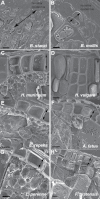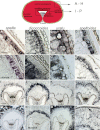Analysis of grain characters in temperate grasses reveals distinctive patterns of endosperm organization associated with grain shape
- PMID: 23081982
- PMCID: PMC3481217
- DOI: 10.1093/jxb/ers281
Analysis of grain characters in temperate grasses reveals distinctive patterns of endosperm organization associated with grain shape
Abstract
Members of the core pooids represent the most important crops in temperate zones including wheat, barley, and oats. Their importance as crops is largely due to the grain, particularly the storage capabilities of the endosperm. In this study, a comprehensive survey of grain morphology and endosperm organization in representatives of wild and cultivated species throughout the core pooids was performed. As sister to the core pooid tribes Poeae, Aveneae, Triticeae, and Bromeae within the Pooideae subfamily, Brachypodium provides a taxonomically relevant reference point. Using macroscopic, histological, and molecular analyses distinct patterns of grain tissue organization in these species, focusing on the peripheral and modified aleurone, are described. The results indicate that aleurone organization is correlated with conventional grain quality characters such as grain shape and starch content. In addition to morphological and organizational variation, expression patterns of candidate gene markers underpinning this variation were examined. Features commonly associated with grains are largely defined by analyses on lineages within the Triticeae and knowledge of grain structure may be skewed as a result of the focus on wheat and barley. Specifically, the data suggest that the modified aleurone is largely restricted to species in the Triticeae tribe.
Figures








Similar articles
-
Endosperm development in Brachypodium distachyon.J Exp Bot. 2011 Jan;62(2):735-48. doi: 10.1093/jxb/erq309. Epub 2010 Nov 11. J Exp Bot. 2011. PMID: 21071680 Free PMC article.
-
High mature grain phytase activity in the Triticeae has evolved by duplication followed by neofunctionalization of the purple acid phosphatase phytase (PAPhy) gene.J Exp Bot. 2013 Aug;64(11):3111-23. doi: 10.1093/jxb/ert116. J Exp Bot. 2013. PMID: 23918958 Free PMC article.
-
Distribution of gluten proteins in bread wheat (Triticum aestivum) grain.Ann Bot. 2011 Jul;108(1):23-35. doi: 10.1093/aob/mcr098. Ann Bot. 2011. PMID: 21693664 Free PMC article.
-
Molecular characterization and functional analysis of elite genes in wheat and its related species.J Genet. 2010 Dec;89(4):539-54. doi: 10.1007/s12041-010-0074-2. J Genet. 2010. PMID: 21273706 Review.
-
Protein accumulation in aleurone cells, sub-aleurone cells and the center starch endosperm of cereals.Plant Cell Rep. 2014 Oct;33(10):1607-15. doi: 10.1007/s00299-014-1651-2. Epub 2014 Jul 15. Plant Cell Rep. 2014. PMID: 25023874 Review.
Cited by
-
Differences in hydrolytic enzyme activity accompany natural variation in mature aleurone morphology in barley (Hordeum vulgare L.).Sci Rep. 2018 Jul 23;8(1):11025. doi: 10.1038/s41598-018-29068-4. Sci Rep. 2018. PMID: 30038399 Free PMC article.
-
Genome-wide characterization of two-component system elements in barley enables the identification of grain-specific phosphorelay genes.BMC Plant Biol. 2025 Feb 17;25(1):209. doi: 10.1186/s12870-025-06161-1. BMC Plant Biol. 2025. PMID: 39962384 Free PMC article.
-
The highly divergent Jekyll genes, required for sexual reproduction, are lineage specific for the related grass tribes Triticeae and Bromeae.Plant J. 2019 Jun;98(6):961-974. doi: 10.1111/tpj.14363. Epub 2019 May 25. Plant J. 2019. PMID: 31021020 Free PMC article.
-
Caspase-like activities accompany programmed cell death events in developing barley grains.PLoS One. 2014 Oct 6;9(10):e109426. doi: 10.1371/journal.pone.0109426. eCollection 2014. PLoS One. 2014. PMID: 25286287 Free PMC article.
-
Localised expression of OsIAA29 suggests a key role for auxin in regulating development of the dorsal aleurone of early rice grains.Planta. 2021 Jul 29;254(2):40. doi: 10.1007/s00425-021-03688-z. Planta. 2021. PMID: 34324072
References
-
- Alves SC, Worland B, Thole V, Snape JW, Bevan MW, Vain P. 2009. A protocol for Agrobacterium-mediated transformation of Brachypodium distachyon community standard line Bd21 Nature Protocols 4 638–649 - PubMed
-
- Becraft PW, Stinard PS, McCarty DR. 1996. CRINKLY4, A TNFR-like receptor kinase involved in maize epidermal differentiation Science 273 1406–1409 - PubMed
-
- Bevan MW, Garvin DF, Vogel JP. 2010. Brachypodium distachyon genomics for sustainable food and fuel production Curent Opinion in Biotechnology 21 211–217 - PubMed
-
- Catalan P, Kellogg EA, Olmstead RG. 1997. Phylogeny of Poaceae subfamily Pooideae based on chloroplast ndhF gene sequences Molecular Phylogenetics and Evolution 8 150–166 - PubMed
Publication types
MeSH terms
Substances
Grants and funding
LinkOut - more resources
Full Text Sources
Research Materials

